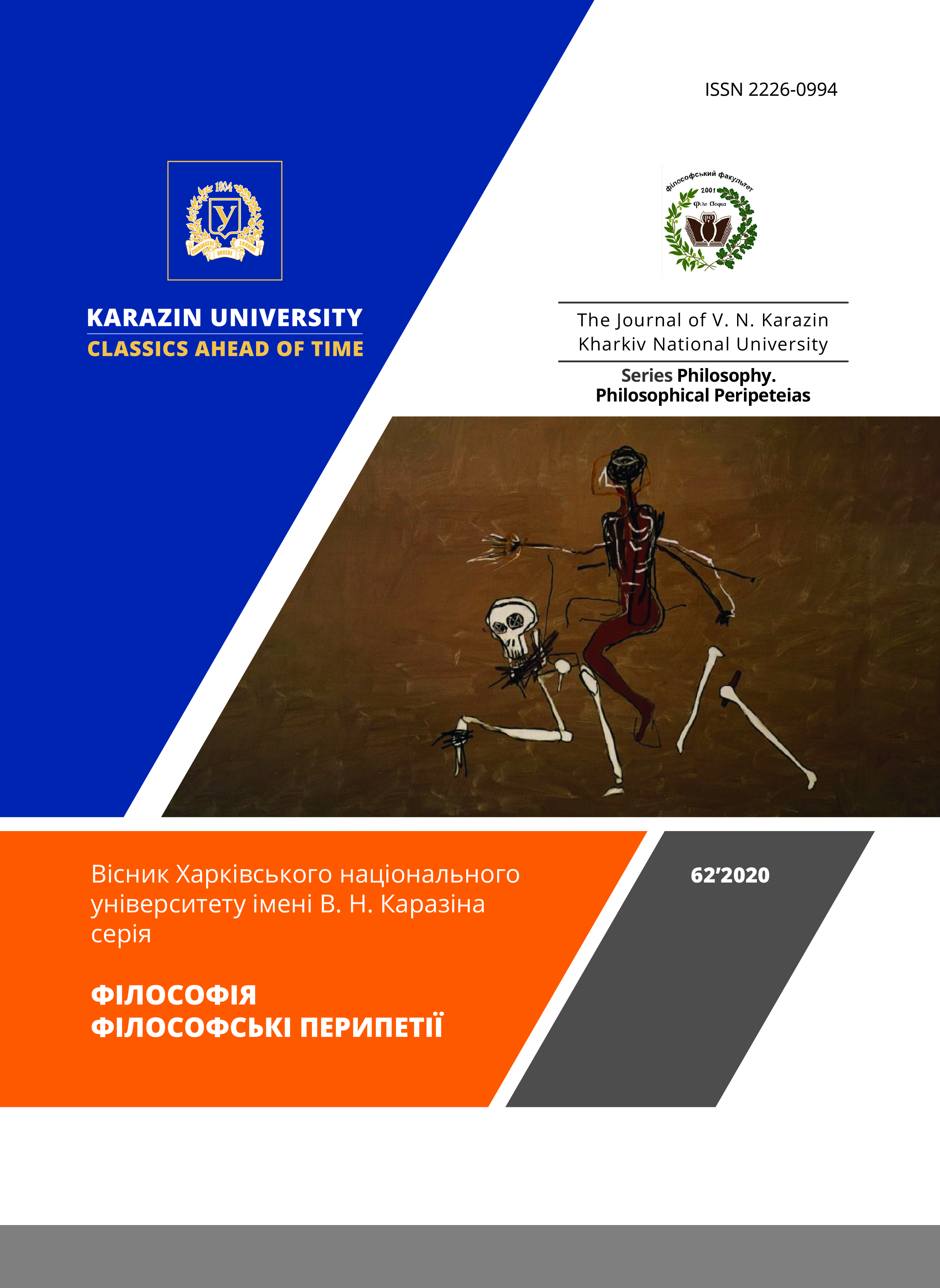EVENT(LESS)NESS OF QUARANTINE VISUALITY
Abstract
The coronavirus epidemic has provoked changes in most spheres of public life and has given rise to many ways of rethinking in matters of security, economics, social philosophy, ethics and so on. Against the background of discussing global issues, some kind of simple but not problem-free perspective is being lost – the spectacle of an epidemic from the spectator’s point of view. This perspective is the most obvious, but requires further analysis. In quarantine conditions, spectator’s contact with the phenomenon is entirely mediated by the screen determining his perception of the epidemic as a media phenomenon. Dividing the existential experience caused by the epidemic (direct one) and the spectator’s experience (indirect one), we put the former in parentheses and focus only on the latter, not being interested in the epidemic as a phenomenon, but in the “phenomenon of the epidemic on the screen”. It is the representation of the epidemic that is the problem: despite real-time broadcasting and the unprecedented “visibility” of the epidemic, quarantine visuality is eventless. Discussion of the epidemic captures the information field and its totality makes a claim to an exceptional event. However, its exclusivity is refuted historically, and eventfulness has no place in the philosophical sense. The spectacle remains – but its mode is specific. The brilliant analysis of spectacle by Guy Deborah and Jean Baudrillard in the case of a modern epidemic is inappropriate: the usual way of experiencing a spectacle in the case of an epidemic is changing – this spectacle is non-spectacular. The spectacle of an epidemic is a “quarantine spectacle”: isolated from “what is” and / or isolating spectators from it. Without displaying death (except in the form of mortality curves that have nothing to do with a specific death), the screen does not reflect what is happening inside the epidemic itself. The fundamental representativeness of death is complemented by a number of invisibilities – the invisibility of the unceremoniously buried dead, the invisibility of isolated patients, the invisibility of physicians protected by their suits and, most importantly, the invisibility of the threat. However, since the screen cannot remain blank, it is filled with images of scarcity and absence: the image of an empty city is decisive for quarantine visuality. The representation of the epidemic, despite the fact that it is broadcast online as a constant update of statistics, avoids both eventness and entertainment.
Downloads
References
/References
Agamben, G. (2020). A Question. Retrieved from https://aitrus.info/node/5456. (In Russian).
Badiou, A. (2013). Philosophy and the Event. Conversations with a short introduction to Badiou’s philosophy by Fabien Tarby. (D. Kraliechkin, Trans.). Moscow: Institute of Social Sciences. (Original work published 2010). (In Russian).
Badiou, A. (2016). Ethics: an Essay on the Understanding of Evil. (V. Artiukh, A. Riepa, Trans.). Kyiv: Komubuk. (Original work published 1993). (In Ukrainian).
Badiou, A. (2020). On the Epidemic Situation. (O. O. Ivanenko, Trans.). Retrieved from http://files.nas.gov.ua/PublicMessages/Documents/0/2020/03/200330171210972-4465.pdf. (In Ukrainian).
Baudrillard, J. (2016). The Spirit of Terrorism. The Gulf War did not Take Place. (A. Kachalov, Trans.). Moscow: Ripol Klassik. (Original works published 1991). (In Russian).
Debord, G. (1992). The Society of the Spectacle (3rd edition). Paris: Gallimard. (Original work published 1967). (In French).
Latour, B., Illouz, E., & Nancy, J.-L. (2020). What is the World After a Pandemic? (A. Riepa, Trans.). Retrieved from https://politkrytyka.org/2020/03/31/yakyj-svit-pislya-pandemiyi-bruno-latur-yeva-illuz-zhan-lyuk-nansi. (In Ukrainian).
Macron, E. (2020). “We are at War”: the Verbatim of Emmanuel Macron’s Speech. Retrieved from https://www.lemonde.fr/politique/article/2020/03/16/nous-sommes-en-guerre-retrouvez-le-discours-de-macron-pour-lutter-contre-le-coronavirus_6033314_823448.html. (In French).
Stepanova, M. (2020). War Without an Enemy: Maria Stepanova about the Misfortune We have been Waiting for So Long. Retrieved from https://www.kommersant.ru/doc/4301417. (In Russian).
Yampolsky, M. (2020). The Epidemic: Ignorance and Truth. Retrieved from https://www.colta.ru/articles/society/24006-mihail-yampolskiy-o-tom-kak-pandemiya-razrushaet-illyuziyu-znaniya. (In Russian).
Žižek, S. (2005). Interpassivity. Desire: Attraction. Multiculturalism. (A. Smirnov, Trans.). (Original work published 1997). St. Petersburg: Aleteia. (In Russian).
Агамбен Дж. Вопрос [Электронный ресурс] / пер. с итал. 16.04.2020. URL: https://aitrus.info/node/5456.
Бадью А. До епідемічної ситуації [Електронний ресурс] / пер. з франц. О. О. Іваненко; під ред. В. Ф. Бурлачука. 21.03.2020. URL: http://files.nas.gov.ua/PublicMessages/Documents/0/2020/03/200330171210972-4465.pdf.
Бадью А. Етика. Нарис про розуміння зла / пер. з франц. В. Артюха, А. Рєпа. К.: Комубук, 2016. 192 с.
Бадью А. Философия и событие. Беседы с кратким введением в философию Алена Бадью / пер. с франц. Д. Кралечкина. М.: Институт общегуманитарных исследований, 2013. 193 с.
Бодрийяр Ж. Дух терроризма. Войны в Заливе не было / пер. с франц. А. Качалова. М: Рипол Классик, 2016. 224 с.
Жижек С. Интерпассивность. Желание: влечение. Мультикультурализм / пер. с англ. А. Смирнова; под ред. В. Мазина, Г. Рогоняна. СПб.: Алетейя, 2005. 156 с.
Латур Б., Іллуз Є., Нансі Ж.-Л. Який світ після пандемії? [Електронний ресурс] / пер. з франц. А. Рєпа. 31.03.2020. URL: https://politkrytyka.org/2020/03/31/yakyj-svit-pislya-pandemiyi-bruno-latur-yeva-illuz-zhan-lyuk-nansi.
Степанова М. Война без врага: Мария Степанова о беде, которую так долго ждали [Электронный ресурс]. 03.04.2020. URL: https://www.kommersant.ru/doc/4301417.
Ямпольский М. Эпидемия: незнание и правда [Электронный ресурс]. URL: https://www.colta.ru/articles/society/24006-mihail-yampolskiy-o-tom-kak-pandemiya-razrushaet-illyuziyu-znaniya.
Debord G. La Société du Spectacle: 3e édition. Paris: Les Éditions Gallimard, 1992. 224 p.
Macron E. “Nous sommes en guerre”: le verbatim du discours d’Emmanuel Macron [Ressource Électronique]. 16.03.2020. URL: https://www.lemonde.fr/politique/article/2020/03/16/nous-sommes-en-guerre-retrouvez-le-discours-de-macron-pour-lutter-contre-le-coronavirus_6033314_823448.html
Copyright (c) 2020 Olha O. Chystotina

This work is licensed under a Creative Commons Attribution 4.0 International License.
Authors who publish with this journal agree to the following terms:
- Authors retain copyright and grant the journal right of first publication of this work under the terms of a license Creative Commons Attribution License 4.0 International (CC BY 4.0).
- Authors are able to enter into separate, additional contractual arrangements for the non-exclusive distribution of the journal's published version of the work (e.g., post it to an institutional repository or publish it in a book), with an acknowledgement of its initial publication in this journal.
- Authors are permitted and encouraged to post their work online (e.g., in institutional repositories or on their website) prior to and during the submission process, as it can lead to productive exchanges, as well as earlier and greater citation of published work.






3.gif)




